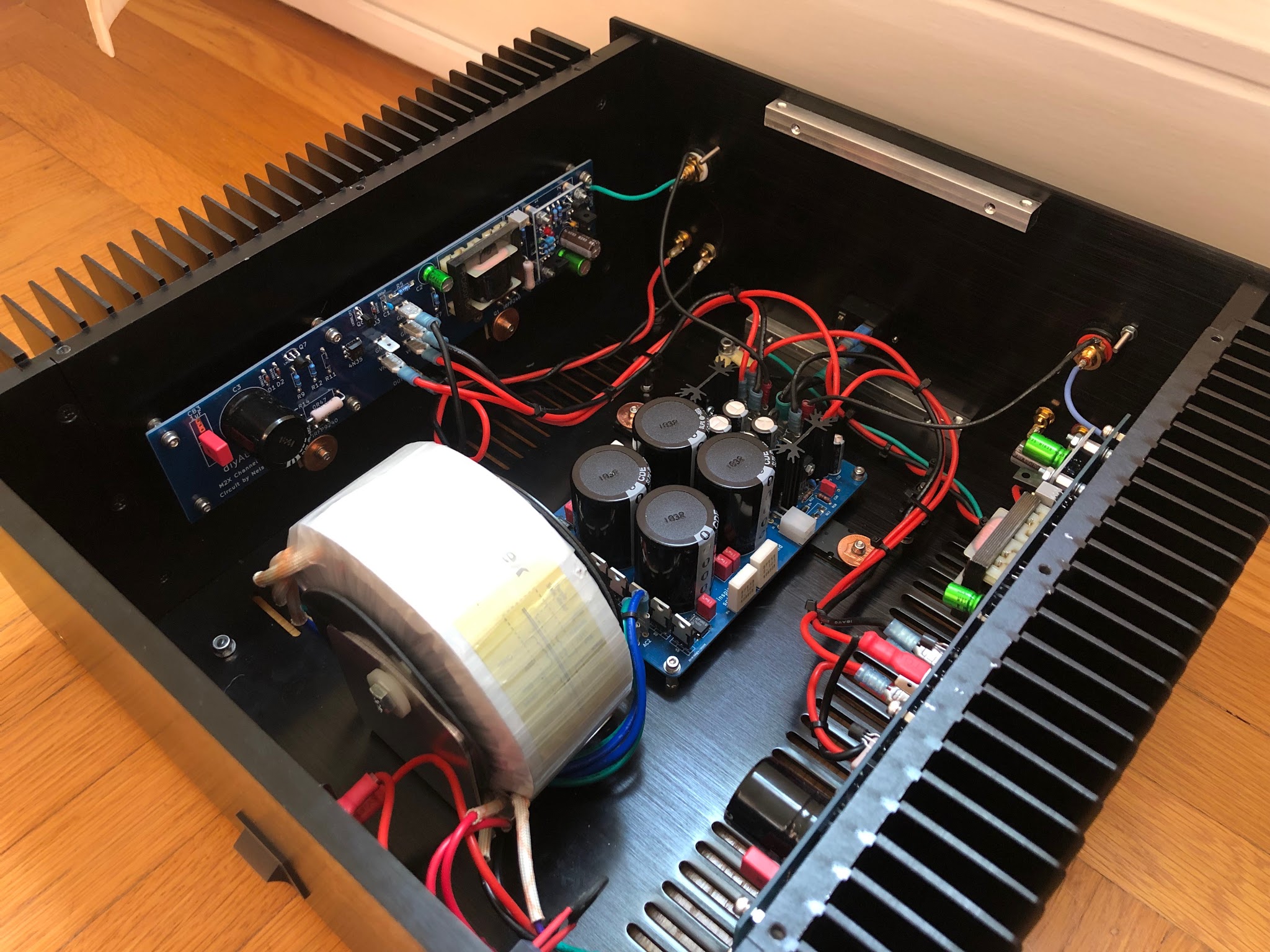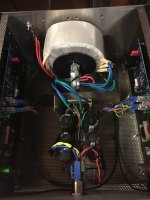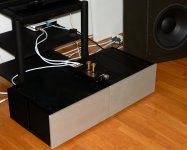with no grease on GBP , in original FW case , there is hardly 55C on bottom of the case , ditto where bridges are bolted
same applies if you mount bridges on Modushop case perforated base plate , no goop
disclaimer - I'm ordinary using them in dual mono config , two bridges per Donut , so relaxed .......
if in doubt - put some goop in between , and don't forget proper torque , spring washers are must
same applies if you mount bridges on Modushop case perforated base plate , no goop
disclaimer - I'm ordinary using them in dual mono config , two bridges per Donut , so relaxed .......
if in doubt - put some goop in between , and don't forget proper torque , spring washers are must
Fair enough - I just decided the cooler the better.
I'm one of those who got an Audiolab MDAC with faulty caps: supposedly it was their makeup + poor qc that was the problem but the hot case (classA hpa/pre) can't have helped.
Still not quite reconciled to my two ACAs providing central heating either. Colour me paranoid.
I'm one of those who got an Audiolab MDAC with faulty caps: supposedly it was their makeup + poor qc that was the problem but the hot case (classA hpa/pre) can't have helped.
Still not quite reconciled to my two ACAs providing central heating either. Colour me paranoid.
The dataseet figure is shown below. At 18 amps average current, the bridge rectifier will be just fine if you keep its case temperature below about 95 degrees C. Of course it will be very happy if you keep its case temperature far, far below 95C. But it will thrive and prosper and meet its specifications even at 95C. Conservatively._
Went back and took more careful measurements. I measured 72 deg C. on the my mounting bolt heads and 62 deg C on the aluminum. Then I went and added a few more bits of scrap aluminum and some arctic silver between all the critical surfaces. I now measure 60 deg C on the bolt heads and 55 deg C on the aluminum. Much better. I measured 38 deg C out near the ends of the wide piece of aluminum so I don't think the extra metal needed to be as wide as it is.
Note: bottom panel of the Pass Labs M2 appears to be brushed, black anodized aluminum, a much better conductor and radiator than the diyStore galvanized steel base plate
Attachments
.......
Note: bottom panel of the Pass Labs M2 appears to be brushed, black anodized aluminum, a much better conductor and radiator than the diyStore galvanized steel base plate
irrelevant
what's enough , it's enough
Hello avdesignguru, I think you are wise to be skeptical of thin, steel, mega-perforated bottom plate as a heatpipe / heatsink. Certainly I myself am skeptical.
But measurements beat opinions every time and you've got measurements. Continue kicking buttt and taking names. Proceed!
But measurements beat opinions every time and you've got measurements. Continue kicking buttt and taking names. Proceed!
This was a nice build of the M2X by SLK23 (post#2272)with the SLB power supply.
The diyAudio First Watt M2x

Using an active bridge like the one built into the SLB power supply eliminates any noticeable heat from the bridge. 0.6v dropout silicon diodes are replaced with ultra low RDson MOSFETs. You have heat from a cap multiplier BJT now, but that pays off with ultra low ripple circa 1mV rms at the amp.
The diyAudio First Watt M2x
Using an active bridge like the one built into the SLB power supply eliminates any noticeable heat from the bridge. 0.6v dropout silicon diodes are replaced with ultra low RDson MOSFETs. You have heat from a cap multiplier BJT now, but that pays off with ultra low ripple circa 1mV rms at the amp.
Last edited:
M2x listening notes
I did some swapping/listening of input modules comparing the M2x to my DIY F6. The F6 was better to my ears than any of the four M2 choices (I did not build the SMD Norwood boards) but not by much. The F6 just doesn't have any "hardness" to it but there is still the detail in the sound. I think perhaps the F6 is a better match to my loudspeakers.
My M2 input preferences ranked as follows:
#1 - Ishikawa (built with some 2N5457/2N5460 JFETs I had on the shelf, Idss around 3mA)
#2 - Mountain View
#3 - Austin
#4 - Tucson
The Tucson with its OPA604 sounded too "bright" to me which surprised me since I like the OPA2134 in my Whammy, although the 604 is an older Burr Brown design. I'll be looking for some alternate opamps to try here.
I can see why some others have modified the Mountain View - it seems to have potential. My rankings are really about how close the M2 comes to the F6, which is really not completely fair. The M2 is a different beast with its own strengths and weaknesses. I'm glad I built it and look forward to tweaking it.
I did some swapping/listening of input modules comparing the M2x to my DIY F6. The F6 was better to my ears than any of the four M2 choices (I did not build the SMD Norwood boards) but not by much. The F6 just doesn't have any "hardness" to it but there is still the detail in the sound. I think perhaps the F6 is a better match to my loudspeakers.
My M2 input preferences ranked as follows:
#1 - Ishikawa (built with some 2N5457/2N5460 JFETs I had on the shelf, Idss around 3mA)
#2 - Mountain View
#3 - Austin
#4 - Tucson
The Tucson with its OPA604 sounded too "bright" to me which surprised me since I like the OPA2134 in my Whammy, although the 604 is an older Burr Brown design. I'll be looking for some alternate opamps to try here.
I can see why some others have modified the Mountain View - it seems to have potential. My rankings are really about how close the M2 comes to the F6, which is really not completely fair. The M2 is a different beast with its own strengths and weaknesses. I'm glad I built it and look forward to tweaking it.
Try the OPA1611, also built by Burr Brown in Tucson. It's only sold in SMD but the bare Tucson PCB has a footprint for it, and you can use thru hole components for all the others.
Also try the Norwood, it's fantastic. I built and tested 15 pairs of Norwood boards and sold them (here). I'm sure more than one of the buyers has decided they strongly prefer another daughter card, so they would be very glad to sell you their Norwoods. Start with member "MEPER", he's never even auditioned his Norwoods to my knowledge.
Also try the Norwood, it's fantastic. I built and tested 15 pairs of Norwood boards and sold them (here). I'm sure more than one of the buyers has decided they strongly prefer another daughter card, so they would be very glad to sell you their Norwoods. Start with member "MEPER", he's never even auditioned his Norwoods to my knowledge.
The Norwood is the only one of the canonical IPS that I haven't built yet. That may change soon. I'm hoping there is a relatively straightforward way to give it about 6 dB of gain. That would put it on even footing with the other high current IPS that I have built.
I love the open and detailed sound of the Austin have have felt no desire to tweak it in any way. Except maybe to give those poor output devices some extra heat sinking ability. The Mountain View has undergone more than one variation in my laboratory. I'm currently enjoying it with a metal can 2N4416A as the input, an LM4040 voltage reference and the output KSC3503 goosed to a little higher quiescent current. Never mind that the Austin was laid out to encourage component substitution, and the Mtn View not as much.
I love the open and detailed sound of the Austin have have felt no desire to tweak it in any way. Except maybe to give those poor output devices some extra heat sinking ability. The Mountain View has undergone more than one variation in my laboratory. I'm currently enjoying it with a metal can 2N4416A as the input, an LM4040 voltage reference and the output KSC3503 goosed to a little higher quiescent current. Never mind that the Austin was laid out to encourage component substitution, and the Mtn View not as much.
avdesignguru,
Thanks for sharing listening impressions. What speakers are you using?
Mid-1980s ADS L980 12" 3-way studio monitors set up in 500 Hz biamp mode. Loudspeakers have a 12" sealed box woofer, 2" dome midrange and 3/4" dome tweeter. They feature precision matched drivers in a mirror image configuration designed for near field monitoring. The loudspeaker woofer input is straight to the voice coil in biamp mode but the mid-high input retains the passive high pass components.
A DIYstore LX Mini ACN crossover, modified for 500 Hz 2-way operation, is configured with a single section 12 dB/oct Butterworth high pass output. This adds to the internal loudspeaker's 12 dB Butterworth passive filter to yield a Linkwitz-Reilly 24db/oct slope for the mid-highs. The low pass output is configured using both filter sections for a total 24 dB/oct LR slope at 500Hz to the woofer.
Preamp is a B1 Korg Xmas Version with Toshiba JFETS (thank you Papa). Mid-high amplification is either the F6 or the M2x. Low frequency amplification is a mid-1980s QSC USA 370, which is a passively cooled class AB amplifier of about 110w/ch and still rockin' hard after 30+ years of heavy use. The Behringer A500 is essentially a copy of the highly reliable QSC design (albeit with plastic output devices instead of metal TO-3s) but that amp has been replaced with the Class-D A800, currently unavailable in our country, probably due to Trump's trade war with China.
Try the OPA1611, also built by Burr Brown in Tucson. It's only sold in SMD but the bare Tucson PCB has a footprint for it, and you can use thru hole components for all the others.
After you try the OPA1611 its hard to get the desire to try anything else. Just added the B1Korg and it has enhanced an already fantastic sound. Thanks again for a fantastic project.
Last edited by a moderator:
Can somebody tell me what is expected price for parts without amp case for M2x (including power supply)?
A general rule of thumb for most Pass 25w Class A amps is about $600 to $750 including chassis, and depending on quality of the components such as resistors and electrolytic caps and film caps, and how you handle the chassis (self-DIY or DIYA audio store or Aliexpress, etc). This is not including special amps that have a certain level of "unobtanium" in them like 2SK170's etc.
So without chassis, subtract $250 for a typical 4U 300mm DIYA Store UMS Dissipante case.
or about $350 to $500, YMMV.
Your price can easily be $1000 to $1500 if you go with dual chassis monoblocks with separate trafos, PSU's, case, etc.
Hi Meper,
Starving student is a nice preamp. Lots more of H2/3 though and you have plenty on the M2X already (circa 0.06%).
Have you tried the Aksa Lender or Melbourne?
X
I have never tried Aksa Lender or Melbourne. I used Passive pre which also sounded very good. It sounded so good that I did not expect the Starving student to sound better. I think the output level of the SS is quite low when I use in on M2X (9 o'clock vol setting plays quite loud) so at these low levels the SS probaby have not as much H2. The input impedance of the M2X Tucson is much higher than a headphone so a power amp is easy to drive for the SS.....so a bit lower H2 than used with a headphone…...properly? …...could be interesting to measure.
With SS I had a feeling of deeper bas.....but it may be an imagination.
- Home
- Amplifiers
- Pass Labs
- The diyAudio First Watt M2x


